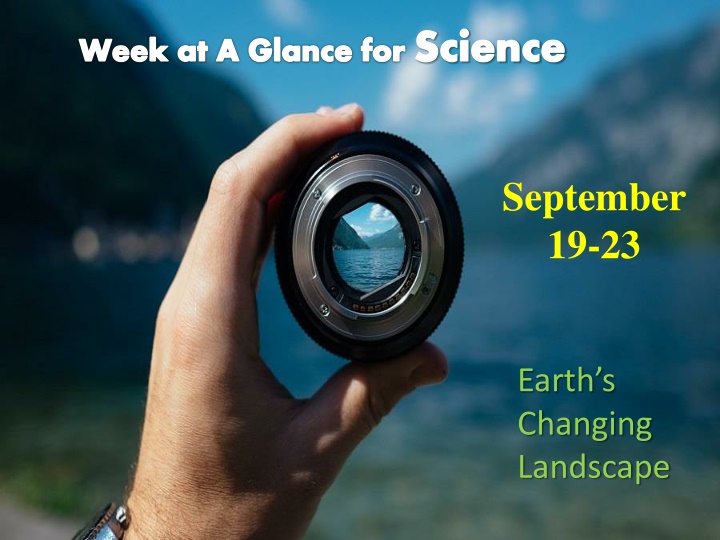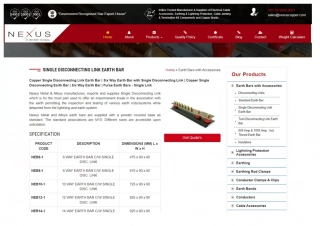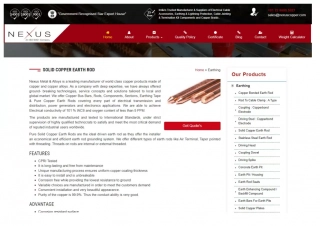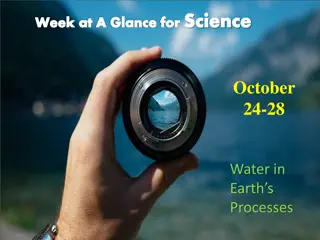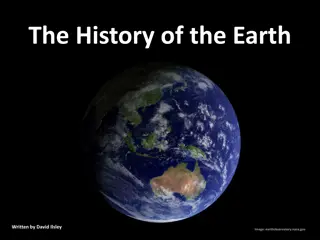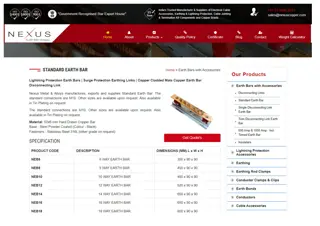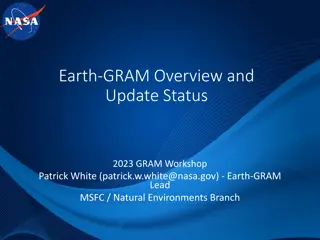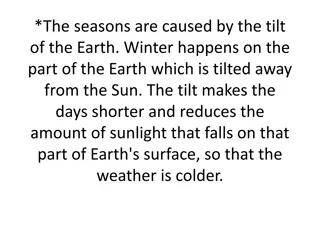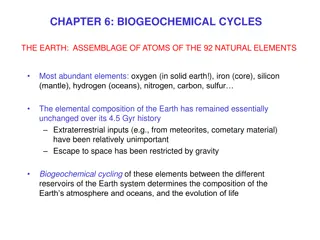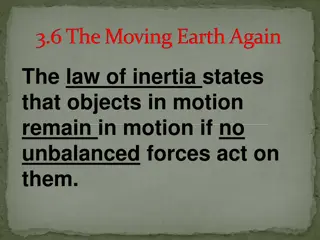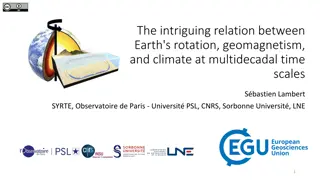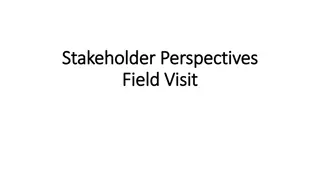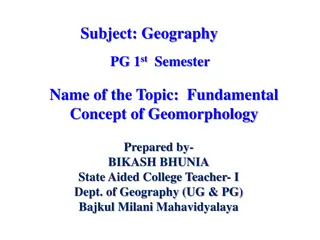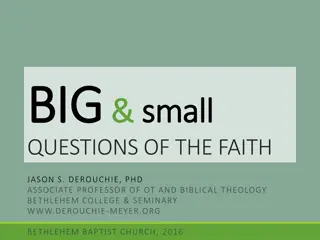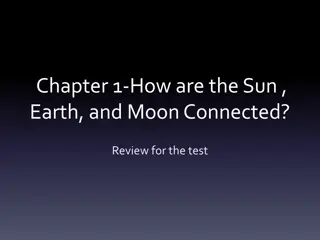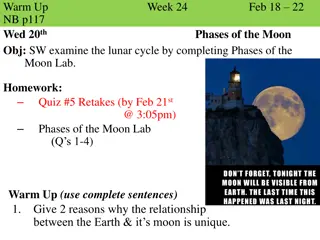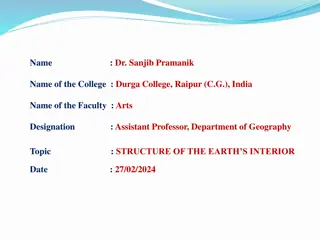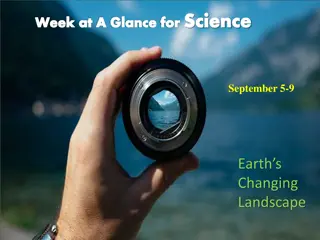Earth's Changing Landscape
Earth, composed of various elements, undergoes transformations through plate tectonics, leading to geological events like earthquakes and volcanic eruptions. Geologist Israel C. White's discovery and the implications of plate movements are discussed in relation to Earth's surface formation, mineral composition, and fossil evidence. The content also covers the characteristics of minerals and how they contribute to rock composition, highlighting the significance of maps and data in supporting claims related to Earth's changing surface and climate.
Download Presentation

Please find below an Image/Link to download the presentation.
The content on the website is provided AS IS for your information and personal use only. It may not be sold, licensed, or shared on other websites without obtaining consent from the author.If you encounter any issues during the download, it is possible that the publisher has removed the file from their server.
You are allowed to download the files provided on this website for personal or commercial use, subject to the condition that they are used lawfully. All files are the property of their respective owners.
The content on the website is provided AS IS for your information and personal use only. It may not be sold, licensed, or shared on other websites without obtaining consent from the author.
E N D
Presentation Transcript
Week at A Glance for Science September 19-23 Earth s Changing Landscape
Earth is composed of the approximately 100 naturally occurring chemical elements in a vast number of combinations. However, 98.5% of Earth s crust is composed of only 8 elements: oxygen (O), silicon (Si), aluminum (Al), iron (Fe), calcium (Ca), sodium (Na), potassium (K), and magnesium (Mg). In materials such as gases, liquids, and glass atoms may occur in random proportions, with the atoms having no fixed relationship in space to each other
In plate tectonics, Earths outermost layer, orlithospheremade up of the crust and upper mantleis broken into large rocky plates. These plates lie on top of a partially moltenlayer of rock called the asthenosphere. Due to the convection of the asthenosphere andlithosphere, the plates move relative to each other at different rates, from two to 15 centimeters (one to six inches) per year. Thisinteraction of tectonic plates is responsible for many different geological formations such as the Himalaya mountain range in Asia, the East African Rift, and the San Andreas Fault in California, United States.
Geologist Israel C White was the first person to report the similarities between coal (fossilized plants) found in Brazilian mines and that found in Africa. His insight helped Alfred Wegener to publish continental drift theory in 1912
S6E5. Obtain, evaluate, and communicate information to show how Earth s surface is formed. B Plan and carry out an investigation of the characteristics of minerals and how minerals contribute to rock composition. F Construct an explanation of how the movement of lithospheric plates, called plate tectonics, can cause major geologic events such as earthquakes and volcanic eruptions. (Clarification statement: Include convergent, divergent, and transform boundaries.) G Construct an argument using maps and data collected to support a claim of how fossils show evidence of the changing surface and climate of the Earth.
Monday, September 19 Standard: S6E5. b Plan and carry out an investigation of the characteristics of minerals and how minerals contribute to rock composition. Learning Target: I can describe how minerals contribute to rock composition. Warm-up: Minerals and Rocks Video Work Session: Direct Instruction; students will take notes on how minerals contribute to rock composition; continue to analyze rock cycle, Earth s layers, and introduce plate tectonics. Closing: TOD Reminders:
Tuesday, September 20 Standard: S6E5. b Plan and carry out an investigation of the characteristics of minerals and how minerals contribute to rock composition. Learning Target: I can describe how minerals contribute to rock composition. Warm-up: Minerals and Rocks Worksheet Work Session: Direct Instruction; students will take notes on how minerals contribute to rock composition; continue to analyze rock cycle, Earth s layers, and introduce plate tectonics. Closing: TOD Reminders:
S6E5. Construct an explanation of how the movement of lithospheric plates, called plate tectonics, can cause major geologic events such as earthquakes and volcanic eruptions. (Clarification statement: Include convergent, divergent, and transform boundaries.)
Wednesday, September 21 Standard: S6E5. g Construct an argument using maps and data collected to support a claim of how fossils show evidence of the changing surface and climate of the Earth. Learning Target: I can explain how fossil evidence shows the changing surface and climate of Earth. Warm-up: Pangea Puzzle Work Session: Direct Instruction; students will take notes on how fossils show evidence of the changing surface and climate of Earth; students will complete a worksheet packet. Closing: Teacher Summary Reminders:
Thursday, September 22 Standard: S6E5. g Construct an argument using maps and data collected to support a claim of how fossils show evidence of the changing surface and climate of the Earth. Learning Target: I can explain how fossil evidence shows the changing surface and climate of Earth. Warm-up: Video on fossils and Pangea Work Session: students will work in small groups to investigate maps and research the claims of fossils and how plate tectonics has changed Earth s surface. Closing: TOD Reminders:
Friday, September 23 Standard: S6E5. Construct an explanation of how the movement of lithospheric plates, called plate tectonics, can cause major geologic events such as earthquakes and volcanic eruptions. (Clarification statement: Include convergent, divergent, and transform boundaries.) Learning Target: I can explain how the movement of plates can cause major geological events. Warm-up: Plate Tectonics Video Work Session: Direct instruction; students will take notes on plate tectonics; research Earth s different plates and how they move. Closing: TOD Reminders:
Students will have 15 minutes of Homework each evening. 4 Squares (usually a drawing) Rock Cycle Puzzle Chapter 1 or 3 Workbook Pages Powerpoint Study Guide Study Notes or Study Guides Watch Video from Week at a Glance
Resources for Unit 1 A Rocks and Minerals Fossils and Plate Tectonics Plate Tectonics
Resources for Unit 1 A What are the Layers of Earth? Layers of the Earth Layers of the Earth Geology The Good and the Beautiful Home school Science 8:47 7 Ways We Know What s Inside the Earth - SciShow 12:08 An Overview of Earth s Layers - 10:07
S6E5. Obtain, evaluate, and communicate information to show how Earths surface is formed. a. Ask questions to compare and contrast the Earth s crust, mantle, inner and outer core, including temperature, density, thickness, and composition. b. Plan and carry out an investigation of the characteristics of minerals and how minerals contribute to rock composition. c. Construct an explanation of how to classify rocks by their formation and how rocks change through geologic processes in the rock cycle. d. Ask questions to identify types of weathering, agents of erosion and transportation, and environments of deposition. (Clarification statement: Environments of deposition include deltas, barrier islands, beaches, marshes, and rivers.) e. Develop a model to demonstrate how natural processes (weathering, erosion, and deposition) and human activity change rocks and the surface of the Earth. f. Construct an explanation of how the movement of lithospheric plates, called plate tectonics, can cause major geologic events such as earthquakes and volcanic eruptions. (Clarification statement: Include convergent, divergent, and transform boundaries.) g. Construct an argument using maps and data collected to support a claim of how fossils show evidence of the changing surface and climate of the Earth. h. Plan and carry out an investigation to provide evidence that soil is composed of layers of weathered rocks and decomposed organic material.
